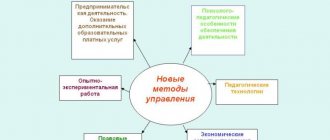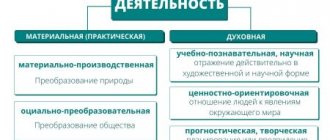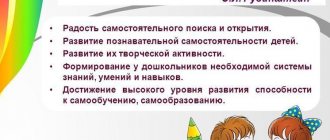Updated July 20, 2022 882 Author: Dmitry Petrov
Hello, dear readers of the KtoNaNovenkogo.ru blog. Every day we work, study, cook lunch, do laundry, do fitness, boxing, embroidery, etc. In other words, we perform some kind of action.
Moreover, the implementation of all of the above does not happen chaotically, but according to a certain algorithm that someone once developed. This algorithm is called technology.
Pedagogy, as the process of educating and training a person, is also based on the use of certain technologies.
Today we’ll talk about what educational technologies are and what types exist.
Pedagogical technology is...
As you already understand, technology is an algorithm (methods and techniques) for performing any actions, pedagogy is the process of upbringing and education.
Consequently, pedagogical technology is a set of methods, forms, methods and techniques intended for the education and training of a person.
Pedagogical technologies (PT) use specific methodologies, methods and techniques. These concepts are discussed in detail in another article on our blog, so I will not repeat them.
Let me remind you briefly: methodology is a strategy, and methods and techniques are tactics for implementing a strategy.
Pedagogical technologies, regardless of type, are characterized by the following features :
- purposefulness (there cannot be “learning for the sake of learning,” each of the PTs has its own goal);
- scientific validity (implemented PT cannot be applied if it does not have a scientific basis);
- planability (learning cannot be “out of the blue”; PT presupposes the achievement of the planned result);
- efficiency and guaranteed results (if there are no real results, then such a PT has no right to exist);
- comfort for the teacher and student (the learning process should not cause negative emotions).
Innovation as a means of developing Russian schools
What are educational technologies? The classification (table according to the Federal State Educational Standard) is practically no different from the classical system; it presents the same innovative methods used by teachers at different levels of schoolchildren’s education. The class-lesson system of classes involves teachers using certain programs in the subject, therefore the classification of pedagogical teaching technologies is carried out taking into account the individual characteristics of each specific academic discipline.
Classification of educational technologies
Differentiation of PT by type depends on the selected classifying feature. Let us consider in the summary table the classification according to the main characteristics:
| Classification sign | Type of pedagogical technology | Explanation |
| content and structure | educational | The learning process provides in-depth knowledge of one or more subjects |
| educational | The main goal is not training, but education | |
| general education | Training is carried out within the framework of the main academic disciplines | |
| form of organization | individual | Education is based on individual communication between teacher and student. Example - tutoring |
| group | A prototype of classroom teaching technology. Initially, students are a group of people of different ages and levels of training. Modern classroom technology assumes that groups of students consist of people of approximately the same level of training | |
| differentiated | A combination of individual and group training | |
| approach to the learner | authoritarian | A student is a subordinate object in the “teacher-student” chain. Characterized by rigid organization of the learning process, suppression of initiative and independence of the student |
| personal | Education is built on the recognition of the student as an individual. The goal is to reveal and increase the student’s potential | |
| cooperative | The basis of the pedagogical process is equal cooperation between teacher and student | |
| predominant teaching method | explanatory and illustrative | Training is carried out on the basis of explanations with simultaneous presentation of visuals |
| reproductive | The essence of learning is “drilling and rote learning” | |
| developing | Training is based on the rapid development of thinking, achieved by the comprehensive development of the student | |
| gaming | The learning process takes place in a game format | |
| problem-search | The teacher sets a problem, students find solutions during a collective discussion |
Each of the existing pedagogical technologies can be classified according to several criteria at once.
For example, PT in secondary schools in our country can be classified (with a few exceptions) as general education, group, authoritarian, explanatory. In principle, this is a classic model of “education for all”, which has confirmed its right to exist with more than 400 years of experience.
Modern pedagogical technologies use both classical methods and techniques used for centuries, as well as innovative ones (including original ones). The choice of a specific PT is dictated by the circumstances of the current situation or the approved provisions of the educational institution.
I’ll explain with an example: let’s say a child comes to study at a music school. He has wonderful hearing and a magnificent voice. It would seem that practice vocals with him, and do not “torment” the child with other objects.
But the status of a music school implies that the student must receive a full set of knowledge in all musical subjects: in the specialty (learning to play a musical instrument), in solfeggio (hearing development), in choral singing, in musical literature.
This is a unified standard that provides a fairly clear framework for teachers in choosing educational technologies. Based on the completed course of study at a music school, the graduate is issued a state-issued certificate.
If the parents sent the child to study at a music studio for vocals, then he will be taught there mainly in singing. This course is not standardized, so the teacher has complete freedom regarding the choice of pedagogical technology. He can “give” the student a voice using the classical method or use the author’s method.
MODERN EDUCATIONAL TECHNOLOGIES IN THE CONDITIONS OF THE GED
MODERN EDUCATIONAL TECHNOLOGIES IN THE CONDITIONS OF THE GED
A.S. Korzhikova
Municipal budgetary educational institution
"Secondary school No. 1"
Mariinsky municipal district
Today the school is aimed at achieving a new, modern quality of education, at solving vital tasks and problems. What should a student master when leaving the walls of elementary school?
Of course, the ability to learn. First of all, the student must have developed universal learning activities (ULA). The federal state educational standards of the new generation tell us this. In order to implement them, I had a need to study and use modern educational technologies in my teaching activities. But first, let’s find out what technology is.
As V. A. Slastenin writes, technology is a set and sequence of methods and processes for converting source materials that make it possible to obtain products with given parameters.
P. I. Pidkasisty characterizes teaching technology (pedagogical technology) as a direction in didactics, an area of scientific research to identify principles and develop optimal systems, to design reproducible didactic processes with predetermined characteristics.
G. M. Kodzhaspirova gives the concept of educational technology - this is a system of methods, techniques, steps, the sequence of implementation of which ensures the solution of the problems of education, training and development of the student’s personality, and the activity itself is presented procedurally, that is, as a certain system of actions; development and procedural implementation of the components of the pedagogical process in the form of a system of actions that ensure a guaranteed result.
The general ideology of the standard, the focus of the educational process on achieving the main expected results of education, imposes special requirements on the selection of educational technologies.
The following educational technologies meet the features of the new standards:
- technologies personality-oriented developmental
education based on
a system-activity approach - technologies based on level differentiation
training
- technologies based on creating learning situations
- technologies based on the implementation of project activities
- technologies based on "embeddedness"
systems of current, intermediate and final
assessment
in the educational process - ICT.
Let's take a closer look at each technology.
Project activities
This technology implies a triad of actions by students with the support and guiding function of the teacher: concept-implementation-product;
as well as passing through the following stages of activity:
- Making a decision to carry out any activity (preparing for any events, research, making mock-ups, etc.).
- Formulating the goals and objectives of the activity.
- Drawing up a plan and program.
- Implementation of a plan.
- Presentation of the finished product.
Preparing various posters, memos, models, organizing and holding exhibitions, quizzes, competitions, performances, conducting mini-research that requires a mandatory presentation of the results obtained - this is not a complete list of examples of project activities in elementary school.
Information and communication technologies
Informatization of education is bringing the education system into line with the needs and capabilities of the information society.
Educational activities based on ICT:
- open (but controlled) space of information sources,
- tools for “adult” information activities,
- environment for information support of the educational process,
- flexible class schedule, flexible composition of study groups,
- modern educational process management systems.
The leading areas of ICT use at the initial stage of education, as a rule, are the following:
- formation of primary skills in working with information
–
searching and sorting, organizing and storing it
; - mastering information and communication tools
as one of the main tools of activity, acquiring skills in working with
general user tools
(primarily with
a text editor
and
presentation editor
,
dynamic tables
);
various multimedia sources
;
some communication tools
(primarily the Internet).
Technology of problem-dialogical learning
This technology is one of the most effective ways to introduce new knowledge and involves the following stages of the lesson:
- creating a problematic situation,
- formulation of an educational problem,
- updating existing knowledge to solve an educational problem,
- finding a solution to a problem, discovering new knowledge,
- application of new knowledge,
- expressing a solution in the form of a verbal thesis, diagram, table, artistic image, etc.
Technology for working with text
The use of this technology makes it possible to most effectively teach schoolchildren independent reading and create conditions for the development of the most important communication skills.
The purpose of technology is complete understanding of texts
.
The tool consists of three stages of working with any text:
- before reading the text
–
skimming reading; - while reading a text
-
studying reading; - after reading the text
– reflective reading, conceptual questions.
Full understanding of a text
means reading three types of text information:
- factual
(which is stated explicitly in the text);
- subtextual
(what is communicated in the text implicitly, read “between the lines”);
- conceptual
(the main idea of the text, its main meanings).
Technology for assessing student educational achievements
The technology for assessing educational achievements suggests assessing in the classroom as it happens in life. The student himself evaluates his activities (in dialogue with the teacher), and the evaluation is given in a qualitative form.
The most important role in the technology of assessing educational achievements is played by the rule of self-assessment. Its use makes it possible to teach each student an algorithm for their self-assessment. Studying becomes comfortable when the student clearly understands what needs to be done and marks himself.
Technology for developing critical thinking
Allows students to develop critical thinking when organizing their work with various sources of information (specially written texts, textbook paragraphs, videos, teacher stories, etc.).
Students are motivated to learn new material by involving them in independent thinking and reflection, as well as by organizing collective, paired and individual work in the classroom.
The purpose of the technology: to teach the student to think independently, comprehend, determine the main thing, structure and transmit information so that others learn about what new he has discovered for himself.
The technology is based on a three-phase process: challenge – realization of meaning (understanding of content) – reflection (reflection).
Call stage:
set students up to achieve goals, update knowledge, and have the opportunity to analyze their opinions on a particular issue.
Stage of realization of meaning:
actively construct new information, establish connections between incremental or previously learned material. At this stage, work is carried out directly with the text (individual, in pairs, etc.).
Reflection stage:
analysis of the process of assimilation of new content that has just been completed and this content itself. The opportunity to evaluate yourself and your comrades in terms of incremental knowledge, as well as the process itself, methods and techniques.
Gaming technologies
Allows the development of all types of universal activities of younger schoolchildren:
- learn the rules of behavior and roles in the group;
- the capabilities of the groups themselves are considered;
- are purchased collaborative skills
collective
activity
, the individual characteristics of students necessary to achieve the set game goals are worked out; - cultural traditions are accumulated, brought into the game by participants, teachers, and additional means - visual aids, textbooks, computer technologies, etc.
The use of modern educational technologies in lessons allows you to develop skills in working with information:
- find, comprehend, and use the necessary information;
- analyze, systematize, present information in the form of diagrams, tables, graphs.
- compare historical phenomena and objects, while independently identifying signs or lines of comparison;
- identify problems contained in the text, determine possible solutions, search for necessary information using various sources of information.
Pedagogy of cooperation
In order to implement a humane and personal approach to the student, modern schools create all the conditions for children to consciously choose the direction for their future professional activity.
Collective creative activities were especially popular during the existence of the traditional Soviet education system. Entire classes of children helped older people remove firewood and carry water. Currently, this technology is returning to educational institutions in the form of volunteer activities. Teachers, together with their students, try to selflessly help those people who need their help. MAE (active learning method) is the sum of pedagogical techniques and actions that are aimed at organizing educational activities. With the help of certain means, conditions are created that motivate children to proactively, independently and creatively study new material in the process of educational activities.
Nuances of traditional methods
Traditional technologies are based on explanatory and illustrative teaching. In the case of using such technology, the teacher in his work pays special attention to the transfer of ready-made educational material. When preparing for lessons, the teacher searches for the most effective ways of presenting new knowledge, the clarity that accompanies his story. The presentation of information, which is determined by the boundaries of the curriculum, mainly involves a monologue by the teacher. It is for this reason that numerous problems often arise in the educational process:
- insignificant independent activity skills of schoolchildren;
- low communication culture;
- lack of a detailed, complete answer from schoolchildren to the question under consideration;
- minimal attention from the audience, lack of desire to work in a team.
The reason lies not at all in the reluctance of children to work and study, but in the specifics of the pedagogical technology itself. The teacher is forced to tell the material provided by the curriculum, the child learns the information, and receives a grade for the answer. The teacher comes to the class with a ready-made task; his task is to subordinate the class to a certain regime and involve the children in educational activities. In this case, there is no talk of any individual personality development. In order for all students to learn the minimum amount of information, the material is repeated many times, and intermediate and final types of control are used.
Older teachers are accustomed to this method of work; they are convinced that only through “cramming” can a strong stock of knowledge, skills, and practical skills be passed on to the younger generation. The results of statistical studies indicate that 73% of the teaching staff are convinced that it is important to establish contact. Children note the need for independent activity; in their understanding, the teacher should become an assistant and mentor, and not a “supervisor.”
Technology Features
The methodological system must answer the following questions: “How to teach?”, “What to teach?”, “Why teach?”.
Educational technology involves effective learning. There are certain criteria according to which the essence of educational technologies is formulated:
- strict and unambiguous identification of the learning goal;
- selection of content, structuring of material;
- optimal organization of educational activities;
- techniques, methods, teaching aids.
In addition, the qualifications of the teacher must be taken into account and an objective methodology for assigning grades must be developed.
Problem-based learning
This technique is based on a heuristic (problematic) approach. Students acquire skills and abilities in the process of independent activity, as a result of which their creative and cognitive abilities develop.
The use of advanced education in the modern educational system is permitted by the second generation Federal State Educational Standard. Children learn to solve problems in different ways, applying specific knowledge depending on the specifics of the current situation. With this approach, each child gets the opportunity to independently determine ways to solve problems.





